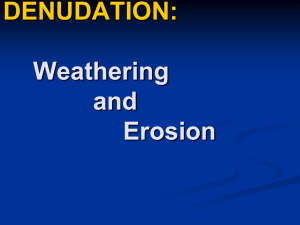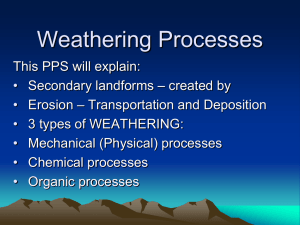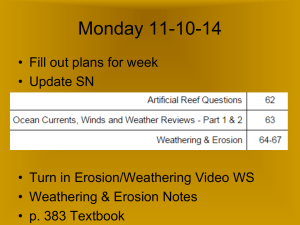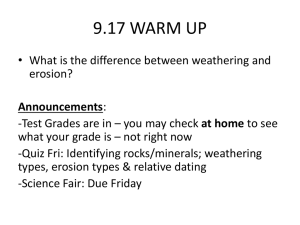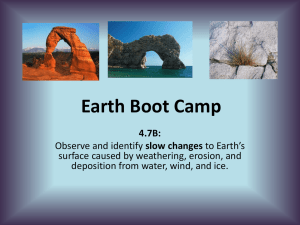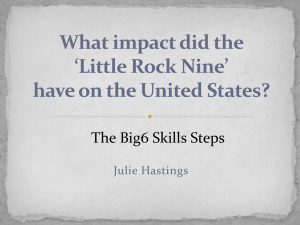Powerpoint 3
advertisement
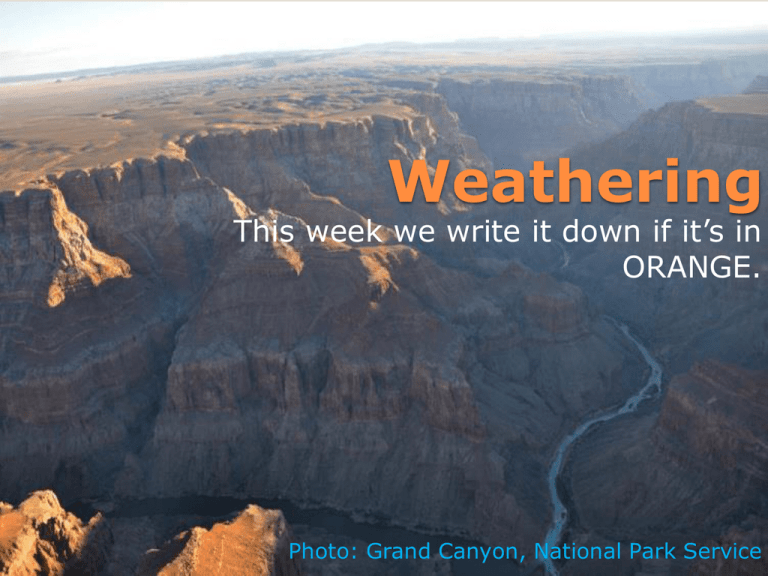
Weathering This week we write it down if it’s in ORANGE. Photo: Grand Canyon, National Park Service Wind blows sand and other sediment against rocks. Little by little, it wears away the rock! This is an example of mechanical weathering. What do you think made the hole in this rock? Water from the river wears away the rock, over thousands of years. This is another example of weathering. Photo: Yosemite Falls, National Park Service webcam What do you think made the notch where the waterfall starts? Weathering is the process that breaks down rock and other substances on Earth’s surface. Part 1: Mechanical Weathering Mechanical Weathering Force of Mechanical Weathering Abrasion Plant Growth Animal Actions Freezing and Thawing Release of Pressure How it Works Here we go again with wind and rock particles sculpting rock! Photo: Delicate Arch, Arches National Park, National Park Service. Abrasion: Sand and other rock particles carried by wind and water grind away rock like sandpaper on wood. Perhaps you have seen this on sidewalks? Photo source: Morguefile.com Plant Growth: Roots of trees and other plants grow in the cracks of rocks and pry them apart. Photo source: Morguefile.com Animal Actions: Animals dig in the soil and loosen and break apart rocks. Perhaps you have seen a frozen bottle get cracked? Or cracks in the road? Why does that happen? Ice Wedging: When water freezes it expands. Ice in the crack of a rock expands and makes the crack larger. Whiteboard Question CHECK YOUR UNDERSTANDING! Mechanical weathering in which rock is worn away by the grinding action of other rock particles is called A. erosion. B. abrasion. C. ice wedging. B. abrasion Release of Pressure: When rocks reach Earth’s surface, reduced pressure can cause cracks and flakes in the rock. Mechanical Weathering Force of Mechanical Weathering How it Works Abrasion Sand and other rock particles carried by wind and water grind away rock like sandpaper on wood. Plant Growth Roots of trees and other plants grow in the cracks of rocks and pry them apart. Animal Actions Animals dig in the soil and loosen and break apart rocks. Freezing and Thawing When water freezes it expands. Ice in the crack of a rock expands and makes the crack larger. Release of Pressure When rocks reach Earth’s surface, reduced pressure can cause cracks and flakes in the rock. Whiteboard Question CHECK YOUR UNDERSTANDING! Ice wedging causes mechanical weathering of rock by means of: A. plant growth. B. animal actions. C. freezing and thawing of water. C. freezing and thawing of water Chemical Weathering Write it down if it’s in ORANGE. Chemical weathering is the process that slowly breaks down rock with chemical changes, including changes in the minerals. This rusty color is caused by oxidation in a wet climate. Whiteboard Question CHECK YOUR UNDERSTANDING! What kind of weathering causes the mineral composition of rocks to change? A. Chemical weathering. B. Mechanical weathering. C. General weathering. A. Chemical weathering Part 2: Chemical Weathering Chemical Weathering Chemical weathering is____________________________________________ _______________________________________________________________ Force of Chemical Weathering Water Oxygen Carbon Dioxide Living Organisms Acid Rain How it Works This limestone cave was created by water dissolving the stone. Photo source: Morguefile.com Water: Water is the most important cause of chemical weathering. When a rock dissolves in water, it mixes completely with the water. What made this old truck rusty? Photo source: Morguefile.com Photo source: Morguefile.com Rust happens to old vehicles, and to rocks. Photo source: Morguefile.com Oxygen: Iron combines with oxygen and water in a process called oxidation. The result is rust. Oxidation of a rock makes it soft, crumbly and red or brown. Limestone. Carbon dioxide: Carbon dioxide in the air dissolves in rainwater, becoming a weak acid called carbolic acid. Acids weather rocks such as limestone and marble. Lichen growing on a rock will weather it. Photo source: Morguefile.com Living organisms: Plants, and other living organisms such as lichen, release weak acids that slowly dissolve rocks. Acid rain: Burning coal, oil, and gas for energy produces pollution. This pollution combines with air and water, to create acid rain, and fast chemical weathering. Photo source: Morguefile.com Whiteboard Question CHECK YOUR UNDERSTANDING! A rock containing iron becomes soft and crumbly and reddish-brown in color. It probably has been weathered by: A. abrasion B. oxygen. C. acid rain. B. oxygen Chemical Weathering Chemical weathering is____________________________________________ _______________________________________________________________ Force of Chemical Weathering How it Works Water Water is the most important cause of chemical weathering. When a rock dissolves in water, it mixes completely with the water. Oxygen A rock containing iron becomes soft and crumbly and reddish-brown in color. It probably has been weathered by Carbon Dioxide Carbon dioxide in the air dissolves in rainwater, becoming a weak acid called carbolic acid. Acids weather rocks such as limestone and marble. Living Organisms Plants, and other living organisms such as lichen, release weak acids that slowly dissolve rocks. Acid Rain Burning coal, oil, and gas for energy produces pollution. This pollution combines with air and water, to create acid rain, and fast chemical weathering. Is it Chemical or Mechanical Weathering? Final Whiteboard Questions Abrasion of a rock by blowing sand is an mechanical example of __________________ weathering. Acid rain washing away the face of a statue is chemical an example of __________________ weathering. True or False? Living things can cause both chemical and mechanical weathering. True A tree’s roots growing through cracks in a rock mechanical is an example of _________________ weathering. Part 3: Rates of Weathering What makes a rock weather fastest? Photo source: Morguefile.com Rate of Weathering The most important factors for the rate (speed) of weathering are 1. rock type; and 2. climate. Photo source: Morguefile.com Mechanical and Chemical Weathering Work Together Photo source: Morguefile.com Photo source: Morguefile.com Mechanical weathering increases the surface area available for chemical weathering. Increased surface area usually results in faster chemical reactions (chemical weathering). Mechanical and Chemical Weathering Work Together Which rock do you think will weather faster? A permeable rock weathers easily because it contains many small, connected air spaces Whiteboard Question CHECK YOUR UNDERSTANDING! A permeable rock weathers easily because it: A. is made up of small particles. B. contains many small, connected air spaces. C. is made up of many minerals. B. contains many small, connected air spaces. How Does Weather Affect Weathering? Photo source: Morguefile.com Which of these places would have faster weathering of rock? Why? Photo source: Morguefile.com Photo source: Morguefile.com Rainforests have warm, wet weather. Photo source: Morguefile.com Wet climates with high temperatures speed up both mechanical and chemical weathering. Photo source: Morguefile.com Whiteboard Question CHECK YOUR UNDERSTANDING! Granite lasts a long time when it is used for building in areas where the climate: A. is cool. B. has lots of acid rain. C. is hot and rainy. A. is cool Whiteboard Question CHECK YOUR UNDERSTANDING! The most important factors in determining the rate of weathering are: A. carbon dioxide and acid rain. B. animal actions and oxygen. C. rock type and climate. D. abrasion and acids from root plants. C. rock type and climate

